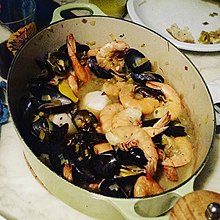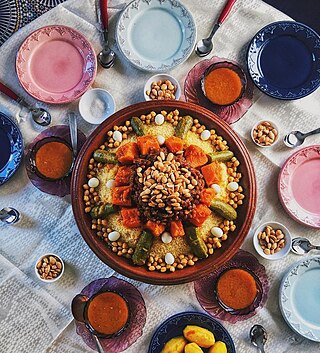
Couscous is a traditional North African dish of small steamed granules of rolled semolina that is often served with a stew spooned on top. Pearl millet, sorghum, bulgur, and other cereals are sometimes cooked in a similar way in other regions, and the resulting dishes are also sometimes called couscous.
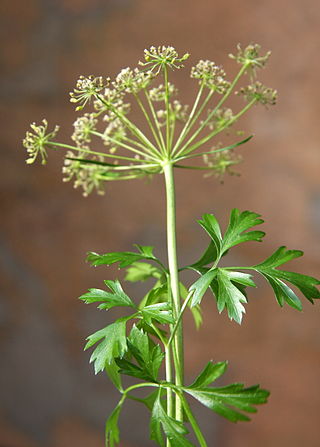
Parsley, or garden parsley is a species of flowering plant in the family Apiaceae that is native to Greece, Morocco and the former Yugoslavia. It has been introduced and naturalized in Europe and elsewhere in the world with suitable climates, and is widely cultivated as an herb and a vegetable.

Chowder is a thick soup prepared with milk or cream, a roux, and seafood or vegetables. Oyster crackers or saltines may accompany chowders as a side item, and cracker pieces may be dropped atop the dish. Clam chowder from New England is typically made with chopped clams and diced potatoes, in a mixed cream and milk base, often with a small amount of butter. Other common chowders include seafood chowder, which often consists of fish, clams, and other types of shellfish; lamb or veal chowder made with barley; corn chowder, which uses corn instead of clams; various fish chowders; and potato chowder, which is often made with cheese. Fish, corn, and clam chowders are popular in North America, especially Atlantic Canada and New England.

Christopher Richard Stein, is an English celebrity chef, restaurateur, writer and television presenter. Along with business partner Jill Stein, he runs the Stein hotel and restaurant business in the UK. The business has a number of renowned restaurants, shops and hotels in Padstow along with other restaurants in Marlborough, Winchester and Barnes. He is also the head chef and a co-owner of the "Rick Stein at Bannisters" restaurants in Mollymook and Port Stephens in Australia, with his second wife, Sarah. He writes cookery books and has presented numerous cookery series for the BBC.

Mediterranean cuisine is the food and methods of preparation used by the people of the Mediterranean Basin. The idea of a Mediterranean cuisine originates with the cookery writer Elizabeth David's book, A Book of Mediterranean Food (1950), and was amplified by other writers working in English.

Iranian cuisine is the culinary traditions of Iran. Due to the historically common usage of the term "Persia" to refer to Iran in the Western world, it is alternatively known as Persian cuisine, despite Persians being only one of a multitude of Iranian ethnic groups who have contributed to Iran's culinary traditions.

Lebanese cuisine is the culinary traditions and practices originating from Lebanon. It includes an abundance of whole grains, fruits, vegetables, fresh fish and seafood. Poultry is eaten more often than red meat, and when red meat is eaten, it is usually lamb and goat meat. Dishes include copious amounts of garlic and olive oil, and dishes are often seasoned with lemon juice. Chickpeas and parsley are also staples of the Lebanese diet.
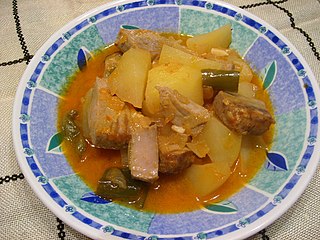
Tuna pot, marmitako in Basque Country and marmita, marmite or sorropotún in Cantabria is a fish stew that was eaten on tuna fishing boats in the Cantabrian Sea. Today it is a simple dish with tuna, potatoes, onions, peppers, and tomatoes.

Rubaboo is a common stew or porridge consumed by coureurs des bois and voyageurs and Métis people of North America. This dish is traditionally made of peas and/or corn, with grease and a thickening agent that makes up the base of the stew. Pemmican and maple sugar were also commonly added to the mixture.

Brudet, brujet, brodet, or brodetto is a fish stew made in Croatian regions of Dalmatia, Kvarner and Istria, as well as along the coast of Montenegro; the brodetto di pesce, or simply brodetto is the signature dish of almost all Italian Adriatic coastal cities. It consists of several types of fish stewed with spices, vegetables and red or white wine, or even vinegar, and the most important aspect of brudet is its simplicity of preparation and the fact that it is typically prepared in a single pot. It is usually served with polenta or toasted bread, which soaks up the fish broth, while other recipes serve it with potatoes or bread. Brudets can significantly vary in style, composition, and flavor, depending upon the types of ingredients and cooking styles used.

Tunisian cuisine, the cuisine of Tunisia, consists of the cooking traditions, ingredients, recipes and techniques developed in Tunisia since antiquity. It is mainly a blend of Mediterranean and native Punic-Berber cuisine. Historically, Tunisian cuisine witnessed influence and exchanges with many cultures and nations like Italians, Andalusians, French and Arabs.
Sea-pie is a layered meat pie made with meat or fish, and is known to have been served to British sailors during the 18th century. Its popularity was passed on to the New England colonies sufficiently to be included in Amelia Simmons's landmark 1796 book American Cookery. Sea-pie is made by lining a saucepan or pot with a thick layer of pastry, and then filling the pot with alternating layers of meat or stew, and vegetables; and, topping the layered ingredients with pastry. There is no set list of ingredients; rather, sea-pie is made with whatever meat and vegetables are on-hand at the time it is made.
Fish stew, when not a stew pond, is a stew with a soup base or ingredient of fish as food.
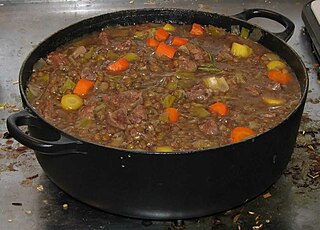
A stew is a combination of solid food ingredients that have been cooked in liquid and served in the resultant gravy. Ingredients can include any combination of vegetables and may include meat, especially tougher meats suitable for slow-cooking, such as beef, pork, venison, rabbit, lamb, poultry, sausages, and seafood. While water can be used as the stew-cooking liquid, stock is also common. A small amount of red wine or other alcohol is sometimes added for flavour. Seasonings and flavourings may also be added. Stews are typically cooked at a relatively low temperature, allowing flavours to mingle.

Corn stew is a stew prepared with corn (maize) as a primary ingredient. Many variations exist in ingredient usage and in methods of preparation. Corn stew is a dish in several cuisines of the world. Mazamorra is a historically old corn stew dish in South America that is prepared using simple ingredients, and is a dish in several other cuisines.
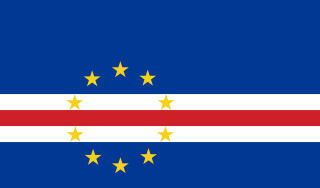
The cuisine of Cape Verde is a West African cuisine largely influenced by Portuguese, Southern and Western European and West African cuisine. Cape Verde was a colony of Portugal from its colonization until 1975.

Tchaka or Chaka is a Haitian stew made from hominy, beans, pumpkin (joumou), and meat. It is used as an offering to the loa in Haitian Vodou. The nutritious soup is also associated with festivities and family time.
